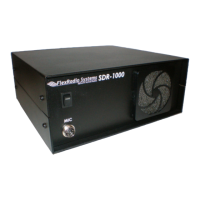S O F T W A R E I N S T A L L A T I O N & S E T U P C H A P T E R 6
Frequency Calibration – DDS Clock Adjustment
Auto Calibration
To calibrate the frequency, enter the frequency of the source in the entry box as seen in the figure above
(e.g. 15.000000MHz). A calibrated signal generator is ideal, but a frequency standard station such as WWV
may be used instead so long as its signal is at least 30dB above the noise floor. A separate transmitter may
also be used as the signal source. We do not recommend calibrating on local AM stations as the correction
may not be as accurate at such low frequencies. Once the frequency of the station or signal generator is
entered, click the top Start button (across from the word Frequency) to run the calibration routine. Using
the manual adjustment routine below may allow slightly better results due to fine adjustments.
Manual Calculation
The calculation for the DDS adjustment is not complicated. Divide the DDS frequency (200MHz) by the
known signal frequency (say, 10MHz WWV) and then multiply by the difference between the known
signal and the measured signal. For example, say you tune the VFO to 10MHz and the peak shows up at
9.999700MHz (difference is 10.0 – 9.999700 = +300Hz). The Clock Offset would be 200/10 * 300 = 6000.
Plugging in 6000 into the Clock Offset control should zero beat the signal. The frequency offset is the actual
clock oscillator offset from its nominal 200MHz output. The oscillator is rated at 100ppm, which yields a
maximum offset of +/- 20kHz from 200MHz. Note that if the measured frequency were 10.000300MHz,
the offset would be -6000. Fine adjustments may be made directly on the Clock Offset control on the
General Tab of the Setup Form.
Level Calibration – Spectrum & S-Meter
For proper calibration of the spectrum and S-meter, some type of calibrated signal source is required. If no
signal generator is available, Elecraft offers an inexpensive XG1 1uV and 50uV Receiver Test Set. To
calibrate the visual spectrum and the S-Meter, set the signal generator to a known strong signal level such as
-73 dBm (no less than 30dB above the noise floor) and tune the radio to place the carrier inside the filter
passband. Enter the frequency (in MHz) and the signal level of the generator in the Frequency and Level
(dB) text boxes respectively as shown in the figure (e.g. 7.040053 MHz and -73dBm). If no calibrated
signal source is available, you may use a second transceiver to either transmit a signal or to find a steady
signal on the air (this will give a much less accurate level calibration). Without use of a calibrated signal
source, the spectrum display and power meter may be off by as much as 10dB or more. Click the middle
Start button across from the word Level to start the calibration. This calibration is accurate to within 0.1dB
with respect to the source.
[The rest of this page has been left blank intentionally]
35 FlexRadio Systems

